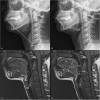No radiographic index predicts difficult intubation using the Optiscope™ in cervical spine surgery patients: a retrospective study
- PMID: 32101151
- PMCID: PMC7043025
- DOI: 10.1186/s12871-020-00966-3
No radiographic index predicts difficult intubation using the Optiscope™ in cervical spine surgery patients: a retrospective study
Abstract
Background: The Optiscope™ can be used for intubation with minimal neck motion. We retrospectively investigated radiographic predictors of difficult intubation using the Optiscope™ by analyzing preoperative radiographic images.
Methods: One hundred eighty-four patients who were intubated with the Optiscope™ under manual in-line cervical stabilization for cervical spine surgery were enrolled. Radiographic indices were measured on preoperative cervical spine lateral X-ray and magnetic resonance imaging images. Difficult intubation was defined as failure or time consumption more than 90 s on the first attempt. To identify significant predictors of difficult intubation using the Optiscope™ and evaluate their diagnostic value, multivariable logistic regression and receiver operating characteristic analyses were used.
Results: Fourty-seven patients showed difficult intubation. There was no significant difference in radiographic indices between the difficult and easy intubation groups, but higher body mass index (BMI) (26.5 [3.0] vs. 24.6 [3.5] kg/m2, P = 0.001), shorter sternomental distance (SMD) (122.0 [104.0 to 150.0] vs. 150.0 [130.0 to 170.0] mm, P = 0.001), shorter interincisor gap (40.0 [35.0 to 45.0] vs. 43.0 [40.0 to 50.0] mm, P = 0.006), and higher incidence of excessive oral secretions (10.6% vs. 2.9%, P = 0.049) were observed in patients with difficult intubation. In multivariable analysis, BMI (odds ratio [95% confidence interval]; 1.15 [1.03 to 1.28], P = 0.011) and SMD (odds ratio [95% confidence interval]; 0.98 [0.97 to 1.00], P = 0.008) were associated with difficult intubation with the Optiscope™. In receiver operating characterstic analysis, the area under the curve for body mass index was 0.68 (95% confidence interval; 0.60 to 0.77, P < 0.001) and that for sternomental distance was 0.66 (95% confience interval; 0.57 to 0.75, P = 0.001).
Conclusions: The incidence of difficult intubation using the Optiscope™ under manual in-line cervical stabilization was 25.5% in cervical spine surgery patients. No significant predictor of difficult intubation with the Optiscope™ was identified among the measured radiographic indices. Although high BMI and short SMD were predictive of difficult intubation with the Optiscope™, their discrimination power was weak.
Keywords: Cervical spine surgery; Difficult intubation; Optiscope™; Predictor; Videostylet.
Conflict of interest statement
The authors declare that they have no competing interests.
Figures



References
-
- Nam K, Lee Y, Park HP, Chung J, Yoon HK, Kim TK. Cervical spine motion during tracheal intubation using an Optiscope versus the McGrath Videolaryngoscope in patients with simulated cervical immobilization: a prospective randomized crossover study. Anesth Analg. 2019;129:1666–1672. doi: 10.1213/ANE.0000000000003635. - DOI - PubMed
MeSH terms
LinkOut - more resources
Full Text Sources
Medical
Miscellaneous

